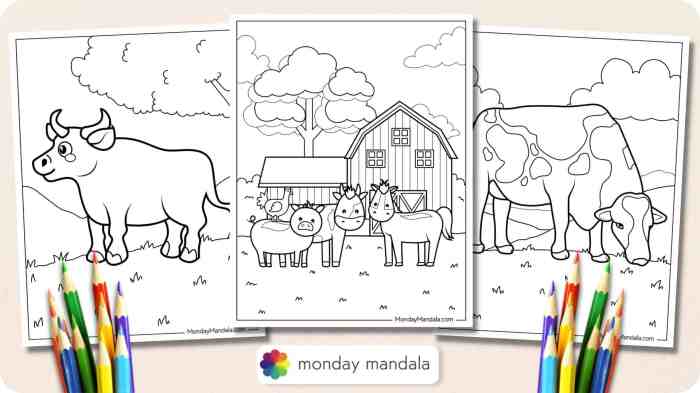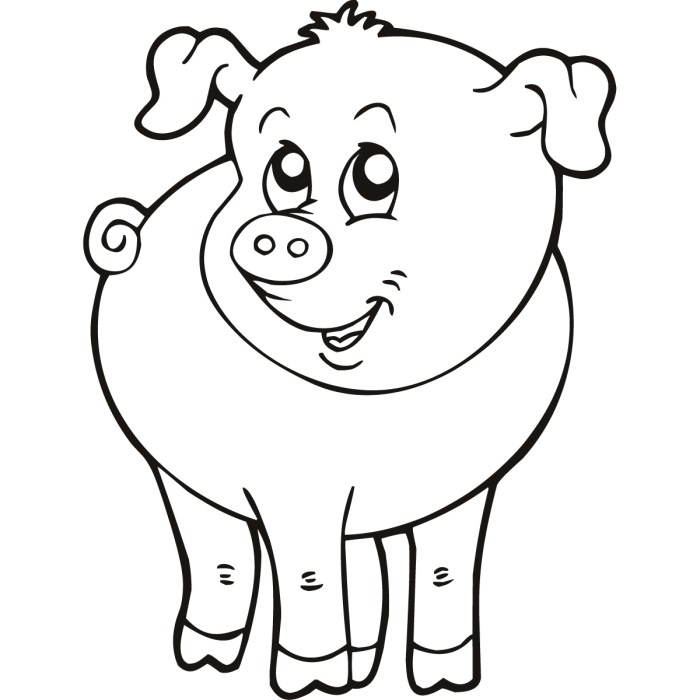Animal Illustrations & Detail

Farm animals coloring worksheets – Creating beautiful and engaging coloring pages for children requires careful consideration of the animal illustrations. Simple yet detailed drawings are key to capturing a child’s imagination and providing a fun and rewarding coloring experience. The choice of style and level of detail should be appropriate for the age group.
So, you’re into farm animals coloring worksheets, huh? That’s pretty chill. But let’s be real, sometimes you need something a little more… instant gratification. That’s where finding awesome farm animal coloring pages printable comes in handy.
Seriously, saves you the hassle of making your own. Then, after you’ve printed those bad boys, you can get back to your meticulously crafted farm animals coloring worksheets. Boom.
Different animal illustrations cater to different skill levels and artistic preferences. Simple shapes and lines are easier for younger children to replicate, while more detailed illustrations challenge older children and provide a greater sense of accomplishment.
Farm Animal Descriptions, Farm animals coloring worksheets
The following descriptions detail five common farm animals, highlighting their key features for easy illustration:
- Cow: A cow’s body is essentially a large, rounded rectangle. Add four legs, each a slightly curved line. The head is a smaller rectangle connected to the body, with two slightly curved horns extending outwards (optional, depending on the breed). Don’t forget the distinctive patches of white and brown, or black and white.
- Pig: A pig’s body is a rounded oval shape. The legs are short and stubby. The snout is a small, rounded triangle. Add small, rounded ears that stick out from the head. A curly tail completes the image.
Consider adding some wrinkles around its snout and body to give it character.
- Horse: A horse’s body is long and slender, resembling a stretched-out rectangle. Its legs are long and thin, ending in hooves. The head is smaller than the body with a long, slightly curved neck. A long, flowing mane and tail add to the horse’s elegance. Consider adding details like muscles and bone structure for older children.
- Sheep: A sheep’s body is a rounded oval. The legs are short and thin. The head is small with small, pointed ears. The most distinctive feature is the fluffy wool, which can be depicted as a cloud-like shape around the body. Consider adding some individual curls or clumps of wool for a more textured look.
- Chicken: A chicken’s body is a rounded shape, with a smaller, rounded head on top. The legs are thin and positioned slightly below the body. Add small, rounded wings extending out from the sides. The beak is a small, pointed triangle. Don’t forget the comb on top of its head.
Illustrative Examples Using Simple Shapes
Let’s illustrate a simple cow: Start with a large oval for the body. Add a smaller circle for the head. Attach four short, straight lines for the legs. Draw two curved lines for the horns. Finally, add some simple markings using curved lines to represent the cow’s spots or patches.
This simple illustration uses basic shapes that are easily replicated by young children. A similar approach can be used for the other animals, using basic shapes as building blocks.
Illustration Styles
Three main illustration styles are suitable for children’s coloring pages:
- Realistic: Realistic illustrations aim for accuracy in portraying the animal’s physical characteristics. This style is more suitable for older children with more developed fine motor skills. It might include details like muscle definition and textural elements.
- Cartoonish: Cartoonish illustrations emphasize exaggeration and simplification of features. Eyes might be oversized, and proportions might be altered for a playful effect. This style is generally easier for younger children to color.
- Minimalist: Minimalist illustrations use simple lines and shapes to represent the animal’s form. Details are kept to a minimum, focusing on the animal’s silhouette. This style is suitable for all ages, allowing children to add their own creative details and interpretations.
Educational Aspects & Activities
These coloring worksheets can be more than just a fun activity; they offer valuable learning opportunities for young children. By incorporating educational elements, we can make the coloring experience both engaging and enriching. The following examples show how simple additions can significantly boost the learning potential.
Labeling Farm Animals
This worksheet features several farm animals – a cow, a pig, a sheep, a horse, and a chicken – each drawn clearly and simply, ready for coloring. Beneath each animal is a blank line. Children can color the animals and then write the name of each animal on the line below. This activity strengthens fine motor skills through coloring and reinforces vocabulary development by associating the visual image with the written word.
The simple design ensures the focus remains on the learning objective.
Counting and Letter Recognition with Farm Animals
This worksheet uses farm animals to practice counting and letter recognition. For counting, we could have groups of farm animals: three cows, two pigs, one sheep, etc. Children color the animals and then count each group, writing the number beside it. For letter recognition, each animal could be paired with its first letter (C for cow, P for pig, etc.).
Children color the animals and then trace or write the corresponding letter. This combines visual learning with number and letter recognition skills.
Farm Animal Maze and Connect-the-Dots
This worksheet presents a simple maze or connect-the-dots activity. A maze could have a path leading from a barn to a specific farm animal, requiring children to navigate through it. A connect-the-dots activity could create a picture of a farm animal, with numbers guiding the children to draw lines connecting the dots. The animals themselves would be simple line drawings ready for coloring, transforming the puzzle solving into a creative and colorful experience.
This worksheet integrates problem-solving skills with the coloring activity.
Worksheet Themes & Variations: Farm Animals Coloring Worksheets

These coloring worksheets can be made even more engaging and educational by exploring different themes and variations. Adding a context to the animals helps children connect with the material on a deeper level, making learning fun and memorable. The variations described below offer opportunities to explore different aspects of farm life and the seasons.
A Day on the Farm
This worksheet depicts a typical day on a farm. Children can color various farm animals participating in their daily routines. For example, cows might be shown grazing in a pasture, pigs rolling in the mud, chickens pecking at the ground, and horses pulling a cart. The illustration could show a vibrant, sunny farm scene with a farmhouse in the background and lush green fields.
Adding details like a farmer tending to the animals or a barn filled with hay further enhances the scene’s realism and provides additional coloring opportunities. The overall effect is a lively and engaging depiction of farm life.
Farm Animal Sounds
This worksheet focuses on the sounds each animal makes. Each animal is illustrated, and a speech bubble next to it displays the sound it makes – “Moo!” for the cow, “Oink!” for the pig, “Baa!” for the sheep, and so on. This worksheet encourages children to associate the visual image of the animal with the sound it produces, strengthening their vocabulary and auditory skills.
The illustrations could be simple and friendly, with each animal clearly depicted in a space next to its speech bubble. A playful border around the worksheet, possibly featuring smaller animal illustrations, would enhance its appeal.
Seasonal Farm Themes
Seasonal themes add another layer of richness to the worksheets. By incorporating seasonal activities and elements, children can learn about the changing seasons and how they affect farm life.
- Fall Harvest: A worksheet could depict animals helping with the harvest – perhaps a horse pulling a wagon filled with pumpkins or sheep grazing in a field of golden wheat. The background could feature autumnal colors such as oranges, reds, and browns.
- Spring Planting: This worksheet could show animals involved in springtime activities, such as lambs frolicking in a green pasture or chickens pecking at newly sprouted seeds. The background could be a vibrant spring scene with blooming flowers and fresh green grass.
- Winter on the Farm: Animals bundled up against the cold, snow-covered landscapes, and a cozy barn scene could be depicted. The color palette could focus on whites, blues, and muted browns.
- Summer Fun on the Farm: A sunny day with animals enjoying the heat, maybe cows in a cool stream or pigs enjoying a mud bath. Bright, sunny colors would create a lively summer atmosphere.
Image Descriptions for Illustrators

Creating charming and simple illustrations for children’s coloring pages requires careful consideration of the animals’ features. The goal is to capture their essence in a way that is both appealing and easy for young children to replicate. The following descriptions provide guidance for illustrators on creating suitable images.
Cow
This coloring page cow should be depicted in a friendly, approachable manner. Its body should be slightly elongated, with a gentle curve to its back. The legs are relatively short and sturdy, ending in cloven hooves. Its head is large in proportion to its body, with large, expressive eyes. For coloring purposes, consider a base coat of light brown or tan.
Add patches of white, perhaps larger ones on its face and underbelly, and smaller scattered patches across its body. These patches should be irregular and organic in shape, not geometrically perfect. The tail should be long and slightly bushy, hanging down towards the ground. Avoid overly detailed shading; keep the lines simple and bold.
Pig
The pig should be illustrated in a simplified, cartoonish style. Its body should be rounded and plump, suggesting a friendly and cuddly nature. The snout should be short and slightly upturned, with small, round nostrils. The ears should be floppy and large, hanging down on either side of its head. Its tail should be curly, adding to its playful appearance.
The pig’s coloring can be a simple pink, with perhaps a slightly darker shade for the snout and hooves. Avoid adding too many details; the focus should be on its charming, rounded shape.
Chicken
The chicken’s illustration should be vibrant and detailed enough to be engaging, but simple enough for children to color. Its body should be compact and rounded, with fluffy feathers suggested by short, slightly curved lines. The comb should be bright red and serrated, standing proudly atop its head. The beak should be short, pointed, and slightly hooked. The chicken’s legs should be thin and yellow, with three clearly defined toes.
The feathers should be suggested rather than meticulously detailed; use short strokes to create the texture. Consider different color variations for the feathers, such as brown, black, or speckled, to provide options for children’s creativity.
